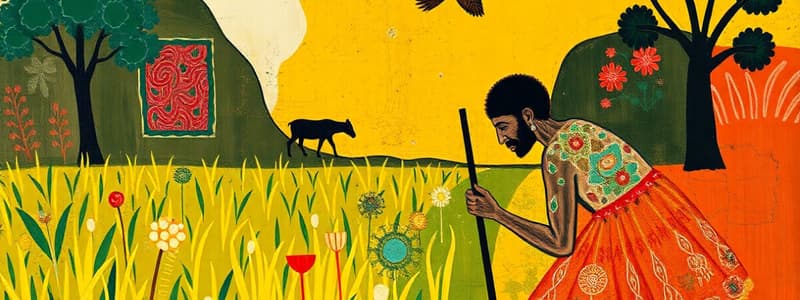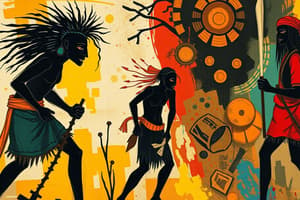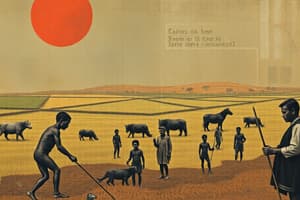Podcast
Questions and Answers
According to the author, what is considered 'the worst mistake in human history'?
According to the author, what is considered 'the worst mistake in human history'?
- The adoption of agriculture. (correct)
- The creation of social hierarchies.
- The abandonment of religion.
- The development of advanced weaponry.
The author contrasts modern life with that of earlier humans. What advantages of modern life does the author list?
The author contrasts modern life with that of earlier humans. What advantages of modern life does the author list?
- More abundant and varied foods, better tools, longer and healthier lives. (correct)
- Elimination of starvation, freedom from physical labor, lack of predators.
- Greater social equality, reduced disease, abundance of leisure time.
- Stronger family units, better mental health, peace.
What do skeletons from Greece and Turkey reveal about the impact of agriculture on human height?
What do skeletons from Greece and Turkey reveal about the impact of agriculture on human height?
- Fluctuations in height depending on the region.
- No significant change in height.
- An increase in average height.
- A decrease in average height. (correct)
What does the author suggest is a major reason why agriculture led to the spread of infectious diseases?
What does the author suggest is a major reason why agriculture led to the spread of infectious diseases?
What is paleopathology, and how does it contribute to the understanding of ancient populations?
What is paleopathology, and how does it contribute to the understanding of ancient populations?
Why does the author reference the Bushmen and other modern-day hunter-gatherers?
Why does the author reference the Bushmen and other modern-day hunter-gatherers?
According to the author, what critical choice did humans make that led to the 'worst mistake'?
According to the author, what critical choice did humans make that led to the 'worst mistake'?
The author mentions that farmers obtained cheap calories at the cost of poor nutrition. What evidence from the text supports this claim?
The author mentions that farmers obtained cheap calories at the cost of poor nutrition. What evidence from the text supports this claim?
What is the author's view on the idea that agriculture led to a 'flowering of artistic expression' due to increased leisure time?
What is the author's view on the idea that agriculture led to a 'flowering of artistic expression' due to increased leisure time?
What does the author suggest about the adoption of agriculture in relation to population density and lifestyle choice?
What does the author suggest about the adoption of agriculture in relation to population density and lifestyle choice?
Flashcards
Agricultural Revolution
Agricultural Revolution
Shift from hunting/gathering to domesticating plants/animals, starting ~10,000 years ago.
Paleopathology
Paleopathology
Study of diseases in ancient human remains.
Height Decrease Post-Agriculture
Height Decrease Post-Agriculture
Skeletons from Greece and Turkey show height decreased after agriculture adoption.
Dickson Mounds Study
Dickson Mounds Study
Signup and view all the flashcards
Agriculture's Nutritional Risks
Agriculture's Nutritional Risks
Signup and view all the flashcards
Disease Spread via Agriculture
Disease Spread via Agriculture
Signup and view all the flashcards
Agriculture's Social Impact
Agriculture's Social Impact
Signup and view all the flashcards
Worst Mistake
Worst Mistake
Signup and view all the flashcards
Hunter-Gatherer Advantages
Hunter-Gatherer Advantages
Signup and view all the flashcards
Kalahari Bushmen
Kalahari Bushmen
Signup and view all the flashcards
Study Notes
- Archaeology is challenging the idea that human history has been a progressive journey.
- Agriculture led to negative consequences that continue to affect us.
- Agriculture brought about social inequality, sexual inequality, disease, and despotism.
- Modern life has some advantages over the Middle Ages, cave dwellers, and apes.
- Modern advantages include abundant food, advanced tools, longer lifespans, safety from starvation and predators, and access to energy from oil and machines.
- Hunter-gatherer societies involve hunting wild animals and foraging for plants.
- Hunter-gatherer life is often perceived as difficult, with constant food searches and a risk of starving.
- Agriculture started around 10,000 years ago, when people started domesticating plants and animals.
- Agriculture spread globally and now hunter-gatherer tribes are scarce.
- According to the ecological modernization perspective, agriculture is more efficient at producing food with less work.
- Agriculture can lead to storing crops and reduces the time needed to pick food.
- Agriculture enabled building Roman architecture and composing classical music like Bach and Beethoven.
- Progressivist views of agriculture are hard to prove regarding how the population was 10,000 years ago.
- Modern-day hunter-gatherers have plenty of leisure time and do not work as hard as farmers.
- The Bushmen dedicate only 12-19 hours per week to obtaining food.
- Hunter-gatherer diets offer more protein and balanced nutrients than the high-carbohydrate diets of farmers.
- Bushmen consume 2,140 calories and 93 grams of protein per day.
- Hunter-gatherers are pushed into the world's worst real estate.
- There is an eco-modernist view that primitive people's lives improved when they switched to farming but this may not be correct.
- Archaeologists study the remains of wild and domesticated plants and animals found in prehistoric garbage dumps to understand when this all changed.
Paleopathology
- Paleopathology is studying signs of disease in ancient remains.
- Mummies and feces give insight on diseases from hookworm and other parasites.
- Skeletons reveal information such as sex, weight, and age to calculate average life spans.
- Paleopathologists use enamel defects on teeth to deduce growth rates of those who had childhood malnutritrion
- Paleopathologists recognize bone scarring caused by anemia, tuberculosis, leprosy, and other diseases.
- Skeletons from Greece and Turkey indicate hunter-gatherers were taller than people who adopted agriculture. The average height was 5’9 for men and 5’5 for women.
- By 3000 B.C. average heights dropped to 5'3" for men and 5' for women.
- At Dickson Mounds, skeletons show health declined when a hunter-gatherer culture switched to intensive farming.
- Farmers had a 50% increase in enamel defects (malnutrition), a fourfold increase in iron-deficiency anemia, a threefold rise in bone lesions, and more degenerative spine conditions.
- Life expectancy at birth decreased from 26 years for the pre-agricultural community to 19 years for the post-agricultural community.
- The Indians at Dickson Mounds took up farming because they had to in order to provide basic needs to a growing community.
Agriculture Was Bad for Health
- Agriculture was bad for health as Hunter-gatherers had a more varied diet, while early farmers only ate staple crops.
- Farmers got lots of calories, but at the expense of poor nutrition.
- Farmers risked starvation if their limited crops failed.
- Agriculture creates crowded societies, which spreads parasites and infectious diseases.
- Crowding leads to increased risk of diseases.
- Epidemics cannot happen when populations are scattered.
- Tuberculosis and diarrheal diseases needed farming, while measles and bubonic plague needed large cities.
Agriculture and Artistic Expression
- Modern hunter-gatherers have just as much free time as farmers.
- Hunter-gatherers produced paintings and sculptures 15,000 years ago.
- Agriculture may led to the elites getting better, whilst the masses got worse.
- Farming sustains more people than hunting and gathering.
- Hunter-gatherers have low population densities; farmers have high population densities.
- Nomadic hunter-gatherers nurse their children for extended periods and are spaced four years apart.
- Farm women can bear a child every two years.
- Population densities of hunter-gatherers grew slowly at the end of the ice ages.
- As there was a need to feed more or limit growth, people failed to anticipate evils of faming.
- There was a need to force out or kill the sensible who refused to abandon lifestyle.
- Agriculture is considered to be the worst mistake as there waas a choice to limit a population which led to trying to increase food, starvation, warfare, and tyranny.
- Hunters and Gatherers hold the most successful and longest-lasting lifestyle.
- Humans struggle with agriculture and cannot solve it.
- As agriculture was adopted, the plight of famine-stricken ancestors gradually spread.
Studying That Suits You
Use AI to generate personalized quizzes and flashcards to suit your learning preferences.




